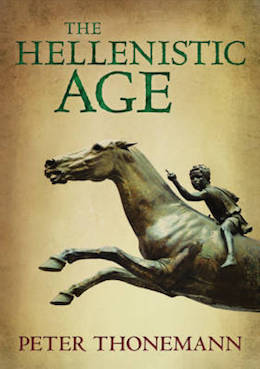The Hellenistic Age refers to that period of time from the death of Alexander the Great in 323BCE to, roughly speaking, the annexation of the kingdom of Pontus by Rome at the end of the Third Mithridatic War. (Some people reckon it ends with the creation of the province of Achaea by Augustus; it’s a lot easier to say where Hellenistic begins than where it ends.)
Yes, I’m reviewing a nonfiction book about the ancient Greek world. Aren’t you excited? I’m excited!
This slender volume (152 pages including its index) from Oxford University Press is a concise and engaging introduction to the personalities, politics, and society of the Greek world after the death of Alexander. Peter Thonemann (who won the Runciman prize for his 2011 work The Maeander Valley: A Historical Geography from Antiquity to Byzantium) has a light and chatty style, while remaining in complete command of his material.
Why is the Hellenistic world exciting? As a result of Alexander’s conquests, this is the first time in recorded history that a person from the shores of the Mediterranean—from the Greek communities of Sicily and the city we now call Marseilles—could travel to the edges of the Hindu Kush and the borders of India, and encounter communities of people who spoke the same language and at times worshipped the same gods. Not until the medieval Islamic kingdoms laid claim to even vaster territories was east-west and west-east movement made possible again to the same degree: Alexandria at the mouth of the Egyptian Nile and Kandahar on the banks of the Arghandab in Afghanistan are both cities founded by (and named for) Alexander the Great.
Alexander didn’t leave a peaceful inheritance, though. He died young, without an adult heir, and his generals and his relatives (including his mother Olympias and his half-sister Kynane) proceeded to fight over the spoils of his empire. The Hellenistic age is an age of warlords who became kings, and kings who became gods: men who spent fabulous sums on soldiers and siege-machinery, public baths and the construction of temples. Among Alexander’s successors are men with names like Seleucus Nikator (Seleucus the Conqueror), Ptolemy Soter (Ptolemy the Saviour), Antigonos Monophthalmos (Antigonos the One-Eyed), Demetrios Poliorketes (Demetrios the Taker-of-Cities); and those whose leadership didn’t result in fancy epithets: Cassander and Lysimachos, Meleager and Perdiccas, Krateros and Antipater.
There are a confusing number of successor kings. (And this is, for the most part, only the FIRST GENERATION after Alexander: indeed some of these lads are already dead by 320 or 319 BCE.) Fortunately, Thonemann has a happy ability to keep them all separate and distinct, giving us in chapter two (“From Alexander to Augustus”) a brief outline of who did the most interesting whats during these turbulent few centuries before passing on, in chapter three (“Demetrius the Besieger and Hellenistic Kingship”) to use Demetrios Poliorketes as an example to explain what Hellenistic kingship was like.
I’ve always had a bit of a soft spot for Demetrios the City-Taker. Because his epithet is a bit of a sarcastic one: he brought some really expensive siege-engines to the island of Rhodes, in order to lay siege to the eponymous city. But after a year’s worth of effort, the city still hadn’t fallen to him, and he was forced to lift the siege and sail away—leaving his expensive toys behind him. (The Rhodians sold them off and were allegedly able to fund the construction of the 30m tall bronze Colossus of Rhodes out of the proceeds.) Hellenistic kings were worshipped as gods for their gifts to Greek cities. But they also forcibly relocated people in their tens of thousands, and killed and enslaved many more. After a life filled with many ups and downs of fortune, Demetrios himself ended his days as a prisoner—in the court of his son-by-marriage, Seleucus Nikator, where he reportedly drank himself to death.
But the Hellenistic age wasn’t all about war. This is also the age of Eratosthenes, who first measured (relatively accurately!) the circumference of the earth, and of a flowering of natural philosophy and poetry funded by the wealth of these rival kings. In his fourth chapter, “Eratosthenes and the System of the World,” Thonemann gives us a brief overview of this flourishing inquiry into the natural world and of the study of literature and arts that accompanied it, before moving on, in chapter five (“Encounters”) to give a short synopsis of the breadth and diversity of intercultural connections this wide (and imperial) Greek world found and formed.
The sixth and final chapter, “Priene,” looks at the Hellenistic life of a small city in the Maeander river valley (toward the river valley of the Büyük Menderes, in south-western Turkey). Priene had a relatively short life as a city on its Hellenistic site: founded in the 320s BCE, by the second century CE, thanks to the silting-up of its harbour, its population had declined until it was little more than a village. The state of preservation of its remains, though, make it an ideal case study, and Thonemann’s concise discussion is vivid and engaging.
While ideal as an introduction to a fascinating period in the history of the ancient world, Thonemann’s The Hellenistic Age is annoying in one respect. Instead of footnotes or endnotes, it has brief passages on “Further Reading” for each chapter. The further reading provides a solid place to start, but in some cases there are off-hand mentions of things that I’d prefer to be able to track down with more precision, myself.
Still, at 152 pages long? It’s a delicious short history book.
The Hellenistic Age is available from Oxford University Press.
Liz Bourke describes herself as a cranky person who reads books. She holds a doctorate in Classics from Trinity College, Dublin. Find her at her blog. Or her Twitter.










